A Trekker's Guide To Bangladesh
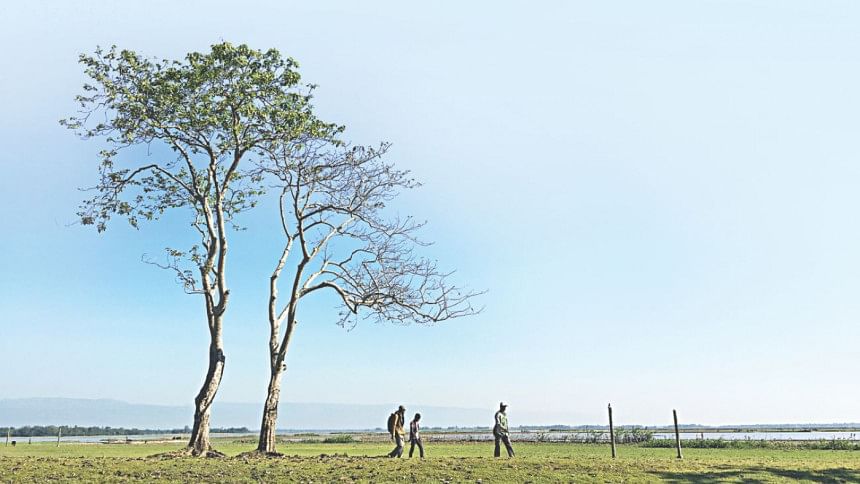
Every time I wander out for a walk outdoors, however short that may be, I have always returned satiated. One feels more profoundly connected to the earth and the environment when one is exploring on feet, rather than on a motorised vehicle. Your senses heightened, as you take in the sights and sounds, and the brain receives the stimuli that it craves from new experiences and exploration. And this is what treks are; a long walk that has a lot more to offer.
During treks, you observe, more deeply, as you slow down and notice the details that would have been impossible to see if you had been on a vehicle. On long treks, there is a sense of liberation and a chance to be footloose. You carry everything you need on your back; from your clothes to beddings, tent and food. You can take a nap under a tree or watch the clouds float by above the hills, tuning in to the harmonious orchestra that only nature can conduct. You can almost slow down time as you connect deeply, almost spiritually, with your surroundings. The ancient act of walking, the simple putting of one step after the another, is meditative and long treks through nature gives the opportunity to reflect and appreciate beauty in many of its forms.
Sometimes the trek is adventurous, strenuous and even dangerous, going through difficult terrains, but any trek always has the ability to surprise you. Treks give a chance to immerse yourself completely in the moment, where the only thing that's important is where you place your next step. And an opportunity to test yourself, both physically and mentally.
It is no wonder then that trekking is now a very popular outdoor activity all over the world. Bangladesh, being one of the densely populated countries, does have some wonderfully scenic and spectacular trails that can take the trekkers through some diverse landscapes and experiences.
We are seeing a growing number of trekkers willing to explore the world on their feet and go for walks through the unknown. Even a few years ago, trekking was not as popular as it is now. In those days, only the hardcore explorers and trekkers ventured out and blazed the trails for other to follow and discover for themselves. Thanks to them, a community has been established that have taken this outdoor activity to the heart.
A WALK THROUGH SINGRA NATIONAL PARK
The National Park in the northern district of Dinajpur is a wonderful sal forest that offers a pleasant trek through the sylvan coolness. There is a small stream that has to be crossed to enter the forest. A few years ago, the stream had to be waded across, but now there is a bridge.
The forest itself is magical, with large sal tress filtering the forest trails in a mosaic of light and shade. Walking through the forest offers a calmness as one can listen to calls of a plethora of birds, including orioles and drongos.
Just off the forest trail, massive termite mounds can be spotted, some even larger than people and enormous spider-webs with colourful giant wood spiders dangling in the middle. Sudden calls of junglefowls or a rushing of monitor lizards through the undergrowth might surprise you.
You will encounter members of the indigenous Santal community deep in the forest paths. A Santal village is just on the other side of the forest. Following the forest trails will lead you to the village. The quaint surrounding will offer you a glimpse into the simple lives of the community.
Beautifully decorated with hand painted murals, the traditional mud houses line the sides of the rural earthen roads, and men and women can be seen working in the fields, while children run around the village. You can fill your water bottle and have a quiet adda with villagers and if you are lucky can even be invited to lunch at one of their houses.
There is an old church at one end of the village that you can visit. Later you can return to the forest and take a different trail back to the starting point.
The trek through Singra is a relatively easy one that can be enjoyed with the family. Best time to visit would be in winter and one can start the trek as late as 9AM in the morning. It is best to take assistance from locals who can guide you through the forest.
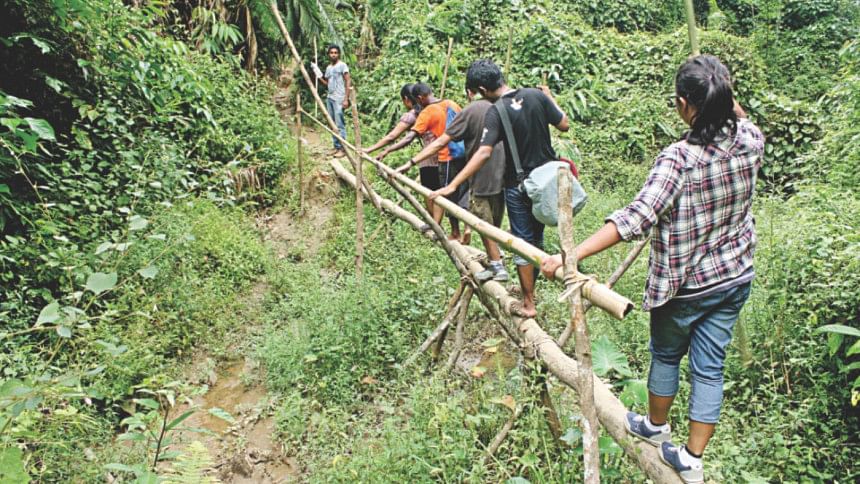
LAWACHARA TREK
Lawachara National Park, in Srimangal of Moulvibazar district, is probably one of my most visited forests in the country, and one that offers a glimpse of the grandeur of the olden days where the forests were truly impenetrable. These days, one can hire a guide and go on treks inside the forest.
Two treks are available, one is a 30-minute walk and the other is 3-hours long. You can take eco-guides who work closely with the local Forest Department and you can contact a guide from the local forest office. For a small fee, one can take assistance from these guides.
The forest itself is incredibly diverse and the trek will take you through a range of micro-habitats. The three-hour trail winds through deep inside the forest, through bamboo groves, and large chapalish trees, down hilly charas or forest streams.
The woodland is usually teeming with birds, especially in winter. Every now and then, the forest echoes in the haunting calls of the Hoolock Gibbons. These primates are considered globally endangered and if lucky, you might catch families of them swinging from one tree to another with their little babies tucked close to the mother's chest.
Crisscrossing through the groves of bamboo, crossing wooden bridges and walking through charas (streams) with sandy beds and clear water, you will find yourself in a Khasi village. The Khasi are an ethnic group and have two villages named Magurchara Punji and Lawachara Punji, in the core zone of the forest. Visiting the villages gives a unique opportunity to catch a peek into the lives of this community living in harmony with the forest.
The village is clean with traditional Khasi households. The community has betel leaf plantations in the forest that is sustainable and eco-friendly. Towards the end, the trek can take you to the edge of the forest through pineapple and lemon gardens.
At the entrance of Lawachara National Park, there is a little gift shop run by the local people that sells traditional articles like clothes, and you can also enjoy the famed seven layered tea at Lawachara!
The 30-minute hike is easy and can be done with the family and little ones. However, the 3-hour trek is much harder and trekkers should be well prepared. It is advisable not to undertake this walk without professional guides.
The trekker must be wearing proper footgear as the forest floor is littered with bamboo spikes and other hazards.
During the rainy season, the trails are slippery and attacks from leeches are common, but the leeches are usually harmless and cause no major damage. Carrying a hat, an insect repellent, sunscreen, a water-bottle, some dry food, an umbrella and a raincoat is advisable.
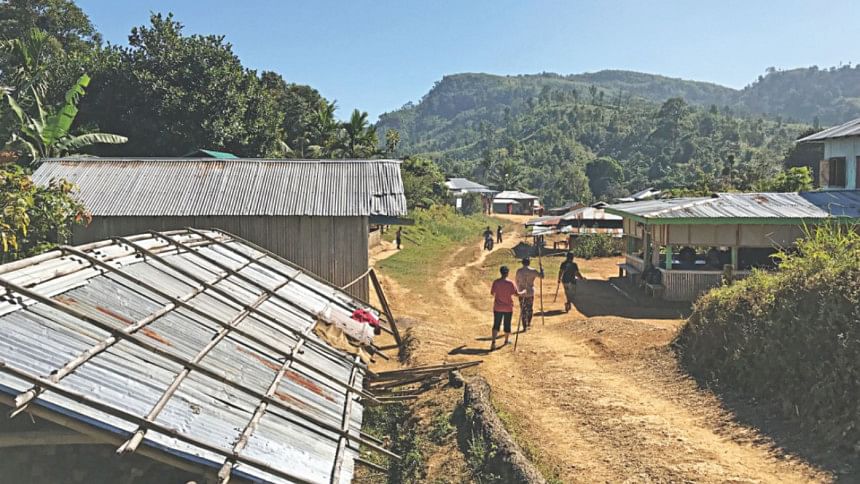
HUM HUM WATERFALL TREK
This breath-taking waterfall lies deep in the remote Rajkandi Reserve Forest and offers a unique opportunity to walk through mystical hilly boulder strewn jhirior stream with crystal clear water trickling through.
The Rajkandi forest is in Moulvibazar district. To reach the waterfall, one has to undertake a tough 3-hour trek, that takes the trekker up and down forested hills and valleys down to the stream that would eventually lead to the waterfall.
The stream is narrow and peaceful with large mossy rocks, trees and bamboo groves reaching high on both sides. The sunlight filters through the greenery, reflecting off the high green walls and clear water, is finally absorbed by the large mossy rocks.
The trek through the stream is in an emerald world inside a fairy-tale. The sound of water flowing over rocks is soothing and offers the trekker a chance to reflect and inhale the beauty of the place.
One can sit on the large boulders listening to the forest surrounding the stream. Many birds and animals use the stream for drinking and bathing. If one remains quiet and respectful, birds like Abbott's babbler and fantails can be seen coming down for a drink or a wash. If the traveller is really lucky, a chance encounter with a barking deer is not unusual.
The jade stream finally leads to the Hum Hum waterfall. The sound of the fall is audible even before one has a glimpse of it. The sound only heightens the anticipation and a sudden bend reveals the cascading waters falling into a large pool at the base.
The trekker can wade into the pool with clean water, take a dip and be completely rejuvenated. After a quick bath and some food, trekkers can return back the same way or if equipped with tents and food, can stay the night camping by the waterfall and turn back the next morning.
The trek to Hum Hum is a difficult one and should only be undertaken if one is physically fit and experienced. Locals can be taken as guides and walking sticks can be hired from near the start of the trek. The best way to reach the starting point is from Srimangal. From there, one can take a CNG autorickshaw to Kolabagan Para at Champarai Tea Estate, the last village before the reserve forest begins.
The trekker should be well prepared with all necessary gear, including proper footwear, first aid kit, hats, insect repellents, etc. If there are plans to camp during the night, equipment like tents and sleeping bags should be taken. Dry food, water and water bottles are absolutely necessary.
The trail is best avoided in the rainy season as there is a chance of flash floods and the hills are extremely difficult to trek. The waterfall, however, is the most beautiful during monsoon, so calculative chances can be taken by experienced trekkers.
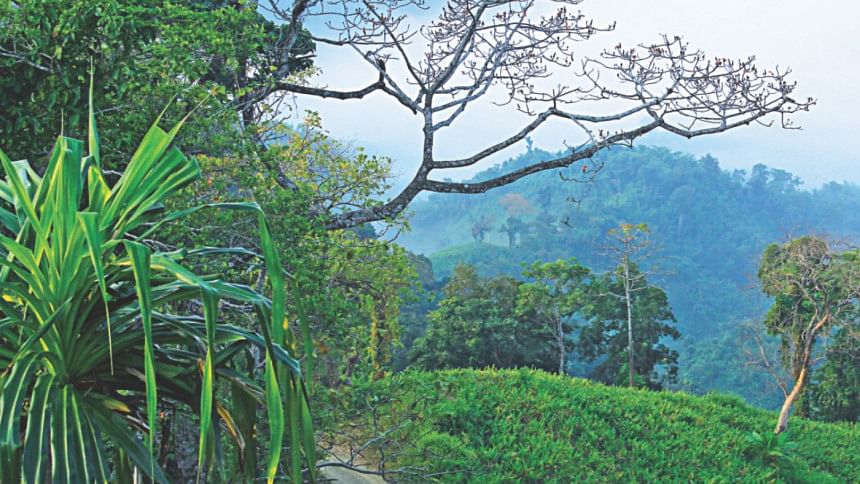
BOGA LAKE AND KEOKRADONG PEAK
This is probably one of the most famous treks in Bangladesh that take you up steep hills, through tribal villages, to a magical lake, passing incredible landscapes and all the way up to one of the highest peaks of Bangladesh. The Boga Lake-Keokradong trek, in Bandarban, is most certainly one of the most exciting and picturesque treks with expansive vistas and layers of green hills extending all the way to the horizon.
The trek will let you experience some breath-taking views, especially the beautifully blue Boga Lake nestled among the deep green hills. You can even take a dip in the clear water of the lake, go fishing using traditional methods or just take a calm walk along its bank, absorbing the beauty of the place.
The walk through the narrow hilly streams or jhiri will allow you to spend some intimate moments with nature and be lost in your thought. The trek is adventurous and uphill but one that has the ability to provide some amazing moments. Staying in local tribal villages will let you experience the lifestyle of the locals in the area as you mingle and chat with them. Following the trail will take you further uphill and finally on to the peak of Keokradong. The sight from the top is amazing, with deep green hills stretching all around and layers of cotton candy clouds floating by below.
The journey really starts at Ruma Bazar and this path can take you all the way to Boga Lake and Keokradong peak. You can reach Ruma Bazar from Bandarban town by catching a ride on a chander gari. Once you reach Ruma, you will have to register your name at the local army check post and hire a local guide and get all the food and other provisions for the night at Boga Lake. These days, you can take two chander gari rides from Bandarban town all the way to Boga Lake. However, if you wish to trek to Boga Lake from Ruma Bazar, you will have to trek through the Jhiri Poth trail along the hilly streams.
The Jhiri Poth will lead you to the small tribal settlement at Boga Lake where you will have to stay the night. Staying the night at Boka Lake, the hike uphill begins for Keokradong, which usually takes three hours. Along the way, you will come across small tribal villages like Darjeeling Para, where you can take a break, have tea, chat with the locals and just admire the view all around. From Darjeeling Para, the trail gets steeper, and finally, will take you to the peak of Keokradong.
The hike itself is long and inexperience trekkers might find it a bit challenging. It is important to carry all necessary items and sufficient food. Winter is the best time to trek but the rainy season will give you the lushness of nature.
Mosquito repellent is a MUST as the hills are notorious for malaria borne mosquitoes. Wear full-sleeve shirts and trousers to avoid mosquito bites, wear socks, and comfortable shoes. The trek itself is not very difficult and can be completed by inexperienced trekkers. It is advisable to hire a guide.
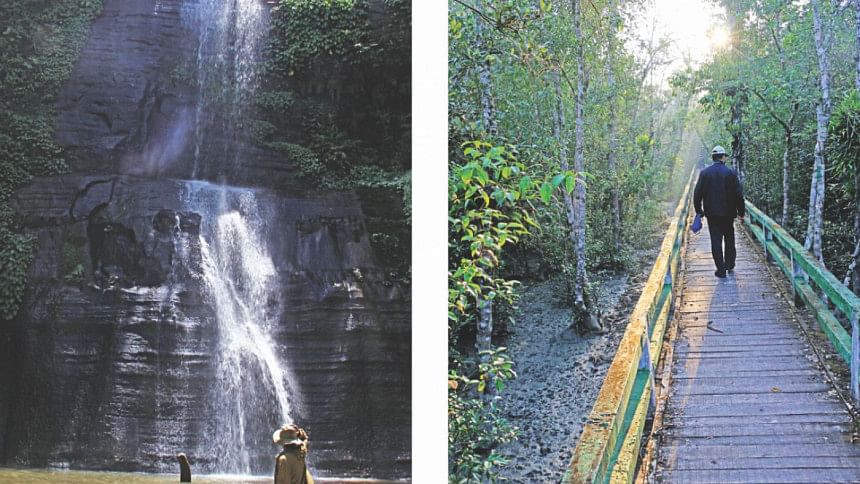
THE BREATHTAKING NAFAKHUM AND AMIAKHUM TREK
This takes you through some of the most pristine natural landscapes of the country, across hills and rivers and streams, climaxing into the cascading waterfalls of Nafakhum and Amiakhum. The magic of the place is indescribable and best to find out for oneself.
It is an entire adventure on its own just reaching the trail, for which you have to find your way to Thanchi from Bandarban town. A chander gari trip will take you there through some hair-raising roads with blind herringbone turns.
At Thanchi, you will have to find yourself a guide, who will get a boat ready for you which can take you through some of the most beautiful sections of the hilly river Sangu, filled with massive boulders and sheer rock faces on both sides. The river will take you all the way to Remakri Bazar passing Tindu Bazar, where you will have to stay the night. From Remakri, the trek finally begins.
From there a short 2-hour trek will take you to Nafakhum waterfall, an epitome of calmness and reflective beauty of nature. The water, coming down in steps from the rock is mesmerising and one can really spend hours and hours just imbibing the beauty of the place.
From there, trek further to small hamlets and villages or ‘paras’ where you can get accommodation and food. You can stay at one of these villages and then the next day you will have to embark on a demanding 2-hour trek that will take you to possibly the most stunning Amiakhum Waterfall.
The walk is long and sections are arduous, but the beauty of the place will be worth every bit of it. It is to be noted that the place is very remote and trekking must be done very carefully. Mosquito repellent is essential to avoid malaria and all other probable precautions should be taken.
All across Bangladesh, there are places hidden, waiting to be explored and blazed a trail through. These are just a handful of them, all of which are stunning in their diversity and the experience they provide. A community of trekkers has been established in Bangladesh and are active on social media, arranging treks regularly. One can easily look them up and tag along.
The most important thing when we go out trekking or travelling is that we are respectful to nature. We should be extra careful not to litter or degrade the natural environment in anyway. We should also show respect towards the local communities of those places, especially the indigenous and tribal communities. We must remember that we are there as guests and it is their home.
Lastly, we have to ensure that these places of magic are kept safe, not only for us to enjoy in our lifetime but also for future generations to come so that they too can enjoy the thrills that only a long winding trek can provide.
The author wishes to thank Fuad Hasan, Sayam U Chowdhury, Nazim Uddin Khan, and others for the assistance and photos.
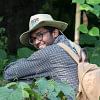
 For all latest news, follow The Daily Star's Google News channel.
For all latest news, follow The Daily Star's Google News channel. 



Comments